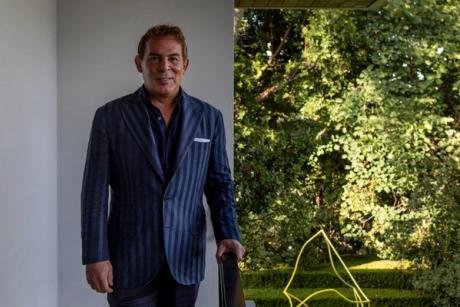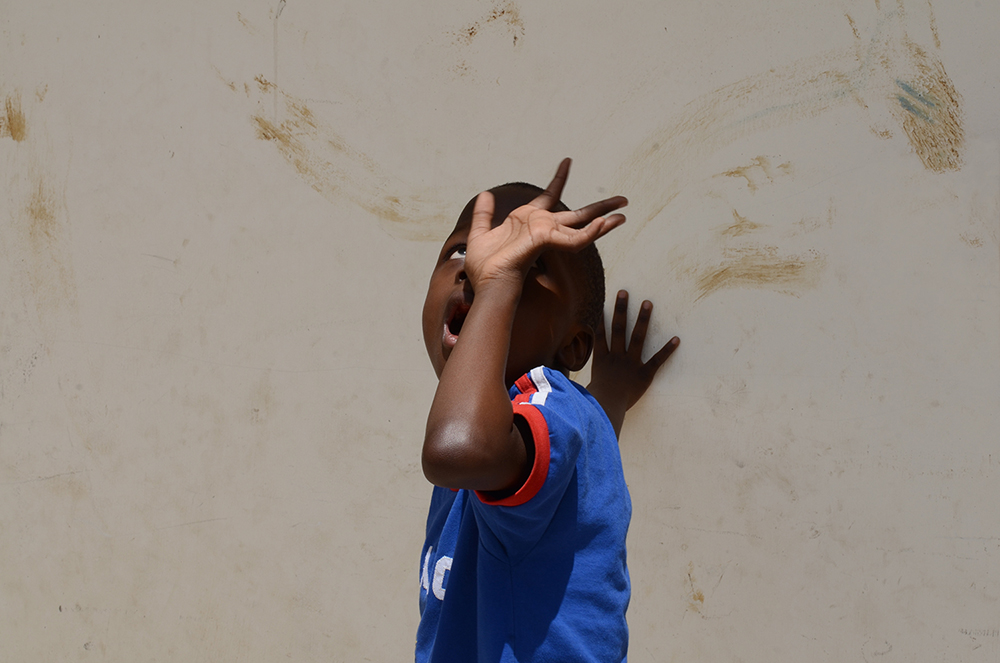Walk the Walk (Sam Durant)
2018 - Installation (Installation)
44 x 33 inches
Native Art Department International
The neon sign Walk the Walk (Sam Durant) overlays a Walk/Don’t Walk Sign crosswalk sign onto the text “You Are On Indian Land Show Some Respect.” The sign asks viewers to not walk on Indigenous lands without respecting it, and, switching between a walking person icon in white and a raised hand icon in red, redirects their actions. This work by Native Art Department International signals a reminder that we–the audience and institution–are located on and occupy traditional territories. The work appropriates and twists white artist Sam Durant’s You Are On Indian Land Show Some Respect (2008) in response to his work Scaffold (2012) installed in 2016-7 at the Walker Art Center in Minneapolis. The structure resembled a high-design jungle gym, with a miscellany of stairways that visitors climb to reach a massive platform. The participatory public sculpture intended to commemorate the seven capital punishments that took place between 1859 and 2006, including the largest mass execution in United States history, in which thirty-eight Dakota Sioux men were hanged, in 1862, in Mankato, Minnesota. The sculpture ignited protests among Dakota Sioux activists in Minneapolis, fuelled not only by anger about the cultural appropriation of murder by the artist but also by the insensitive resonance with the current suicide rate among Native American teenagers–the highest of any population in the United States. The protests eventually lead to the removal and dismantlement of the sculpture. The sculptural remains were handed to Dakota elders who buried the material and the Dakota Oyate now retains intellectual property of the work. Anchored in the long history of appropriation in the arts, Walk the Walk (Sam Durant) engages with complex and recent discussions about cultural appropriation in the art world as recent controversies have unfolded such as Dana Schutz at the Whitney Biennale, Sam Durant at the Walker, Luke Willis Thompson for the Turner prize. Namely: How can artists responsibly use images that are not their own, especially when those images are tied to the history and trauma of another culture? And how can museums display such work while respectfully engaging with marginalized communities?
Native Art Department International is a collaborative project created in 2016 and administered by Maria Hupfield and Jason Lujan. Their work–spanning panel talks, collective art-making, performances, theater, sculpture, and video–has often addressed critical issues relevant in the art world while integrating art historical and references from Native American and Canadian art. Within this context, they have examined systems of support and created strategies to challenge narratives that essentialize and instrumentalize artists’ practices based on their identities. More specifically, their practice explores the potential of collaborative and collective ways of working and producing art to challenge the dominant (art) historical canons and rectify the absence of overlooked narratives and perspectives.
Colors:
Related works sharing similar palette
» see more

© » THEARTNEWSPER
Collector Eugenio López Alonso on his museum’s tenth anniversary and Mexico City’s rising profile in the art world Art market Museums & heritage Exhibitions Books Podcasts Columns Technology Adventures with Van Gogh Search Search Collectors interview Collector Eugenio López Alonso on his museum’s tenth anniversary and Mexico City’s rising profile in the art world Visitors to the city during Zona Maco can also take in Museo Jumex’s anniversary group show, curated by New Museum director Lisa Philips Osman Can Yerebakan 8 February 2024 Share Collector and Museo Jumex founder Eugenio López Alonso Brian Harkin Museo Jumex, a major engine in Mexico City’s transformation into a contemporary art hub, is celebrating its tenth anniversary with programming that includes the group exhibition Everything Gets Lighter , curated by Lisa Philips, the director of New York City’s New Museum, and the upcoming first survey of Damien Hirst’s work at a Mexican institution...

© » ARTS EQUATOR
Rainforest Fringe Festival 2018: Top 8 Picks | ArtsEquator Thinking and Talking about Arts and Culture in Southeast Asia Articles June 21, 2018 By Nur Athirah Abdullah The Rainforest Fringe Festival 2018 (RFF 2018) is less than a month away! Not to be mistaken for the Rainforest World Music Festival, one of the region’s best world music festivals, the Fringe is a cool combo of the very best of Sarawak’s music, art, craft, film, photography, and food...
Related works found in the same semantic group
» see more

© » KADIST
Sky Hopinka
2017Dislocation Blues by Sky Hopinka is a portrait of the 2016 Standing Rock protests against the Dakota Access Pipeline in South Dakota...

© » LENS SCRATCH
Inner Vision: Photography by Blind Artists: Karren Visser - LENSCRATCH Fine Art Photography Daily Subscribe / Contact / About Home Photographers Browse All Browse Alphabetically Browse by Genre Browse by Subject Browse by Place Browse by Process Features Publisher’s Spotlight The States Project Alaska Alabama Arizona Arkansas California Colorado Connecticut Delaware District of Columbia Florida Georgia Hawaii Idaho Illinois Indiana Iowa Kansas Kentucky Louisiana Maine Maryland Massachusetts Michigan Minnesota Mississippi Missouri Montana Nebraska Nevada New Hampshire New Jersey New Mexico New York North Carolina North Dakota Ohio Oklahoma Oregon Pennsylvania Rhode Island South Carolina South Dakota Tennessee Texas Utah Vermont Virginia Washington West Virginia Wisconsin Wyoming Content Aware DEVELOPER Mixtapes Art and Science Competition: The Heart of the Matter Book Reviews Geometry In the Dark Insecta Magic Night The Natural World/Nature Women and Earth The Art of Healing Lenscratch Student Prize Winners 2023 2022 2021 2020 2019 2018 2017 2016 2015 2014 2013 Notes from a Curator Exhibitions Interviews Articles Photographers on Photographers Resources Artist Residencies Calls For Entry Lenscratch Library Portfolio Reviews Photo Festivals Online Magazines Print Magazines Sites of Interest Organizations and Institutions Photography Charities Grants Submit About Submissions Submit to Lenscratch Exhibitions Submit To Art and Science Award Submit to Student Prize Submit Your Project Shop Home Photographers Browse All Browse Alphabetically Browse by Genre Browse by Subject Browse by Place Browse by Process Features Publisher’s Spotlight The States Project Alaska Alabama Arizona Arkansas California Colorado Connecticut Delaware District of Columbia Florida Georgia Hawaii Idaho Illinois Indiana Iowa Kansas Kentucky Louisiana Maine Maryland Massachusetts Michigan Minnesota Mississippi Missouri Montana Nebraska Nevada New Hampshire New Jersey New Mexico New York North Carolina North Dakota Ohio Oklahoma Oregon Pennsylvania Rhode Island South Carolina South Dakota Tennessee Texas Utah Vermont Virginia Washington West Virginia Wisconsin Wyoming Content Aware DEVELOPER Mixtapes Art and Science Competition: The Heart of the Matter Book Reviews Geometry In the Dark Insecta Magic Night The Natural World/Nature Women and Earth The Art of Healing Lenscratch Student Prize Winners 2023 2022 2021 2020 2019 2018 2017 2016 2015 2014 2013 Notes from a Curator Exhibitions Interviews Articles Photographers on Photographers Resources Artist Residencies Calls For Entry Lenscratch Library Portfolio Reviews Photo Festivals Online Magazines Print Magazines Sites of Interest Organizations and Institutions Photography Charities Grants Submit About Submissions Submit to Lenscratch Exhibitions Submit To Art and Science Award Submit to Student Prize Submit Your Project Shop Inner Vision: Photography by Blind Artists: Karren Visser by Karren Visser December 18, 2023 © Karren Visser, Autism in Africa, 2013...

© » KADIST
Pavel Aguilar, Carlos Amorales, Jonathas de Andrade, Pavel Aguilar, Edgardo Aragón, Fredi Casco, Rometti Costales, Sam Durant, León Ferrari, Joscelyn Gardner, Beatríz González, Pierre Huyghe, Guillermo Kuitca, Cristóbal Lehyt, Jesse Lerner, Alfredo López Morales, Teresa Margolles, Noé Martínez, Cildo Meireles, Eustaquio Neves, Nohemí Pérez, Naufus Ramírez Figueroa, Antonio Reynoso, Pablo Swezey and Carla Zaccagnini...



